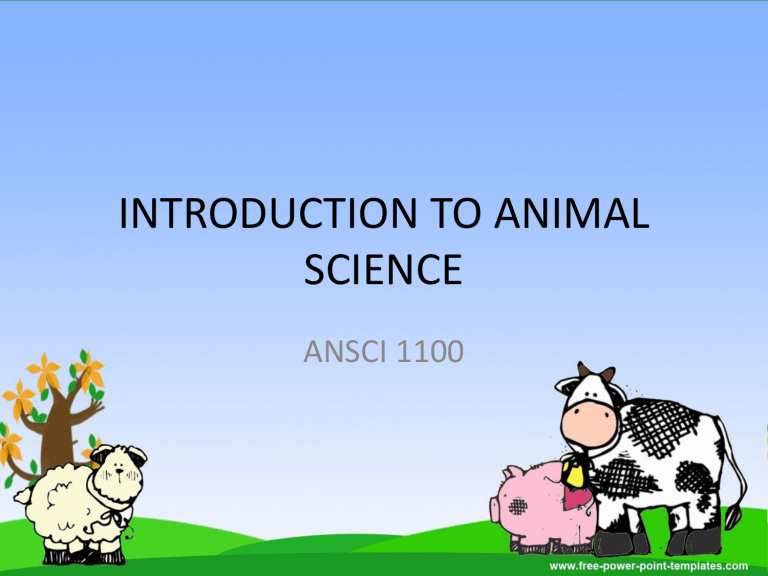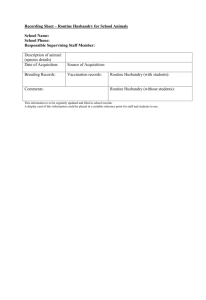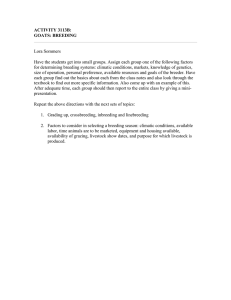
INTRODUCTION TO ANIMAL SCIENCE ANSCI 1100 Grading System • • • • Term Exams - 60 % Quizzes - 25% Term Paper – 5% Attendance - 10% • Lecture 60% • Laboratory 40% • PASSING SCORE 60% Course Content • • • • • • Unit I – Introduction to Animal Science Unit II – Anatomy and Physiology Unit III – Genetics and Breeding Unit V – Animal Nutrition Unit IV – Animal Health Unit VI – Slaughtering, Processing and Marketing of Farm Animals GENERAL OBJECTIVE • To discuss the interrelationship of plants, animals and man, and their roles in the ecological system • This will also help the students appreciate the contributions of animals to agricultural development and the economy in general. Specific Objectives 1. To discuss the relationship of man, animals and the ecosystem 2. To give the economic benefits of animals to mankind 3. To determine the contributions of animals to agricultural development and its relation to population problem, and 4. To appreciate the development of animal science and how it affects the animal industry Terminologies • Symbiosis – is a biological situation in which at least two different kinds of organisms interact • Animal Science – science that deals in managing aspects related to production of domesticated animals and animal products • Domestic animals – animals which breeding is or can be controlled by humans Man Ecosystem Animal Role of Livestock • What are the specific roles (naibibigay) of livestock? Economic Contribution of Animals • Philippine animal industry contributes billions of pesos • Main services: food, fiber, clothing, transportation, tillage • Support services: recreation (horses, fancy breeds), and aide for differently abled (service dogs) Economic Contribution of Animals • Other uses: model for human experiments especially in the medical field, production of pharmaceutical products (vaccines), source of tissue or organ for human ailments (xenotransplantation) • Harvest of cowpox virus from calves in the late 1800’s Pharmaceutical products from transgenic animals Challenges in Animal Production • Animal Welfare issues • Environmental impact of large-scale animal production such as greenhouse gases, foul smell, and pollution in bodies of water • Alternative plant based food for meat and other animal products • Laboratory cultured meat Tissue Cultured Beef Animal Science Vs. Animal Husbandry • Animal husbandry - how farm animals are bred and cared for, typically by farmers • Animal Science - study of animals and may help develop new techniques in animal husbandry based on research to increase growth and production, and reduce disease and death rates Factors Involved in Animal Management 1. Motivation of the persons involved 2. Level of knowledge and skills 3. Housing 4. Climate 5. Genetics 6. Health care 7. Product technology 8. General Management Main Constraints in Improving Animal Production 1. Ecological factors – land topography; soil fertility; temperature; RH; plant growing season 2. Biological factors –genotype, animal diseases and parasites; 3. Socio-economic factors – supply and demand relationship; input-output ratio; prices; religion culture and tradition; politics THANK YOU!

